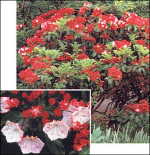Search engine visitors - click here to access entire "$ensible Home" web site
Click here to see a descriptive illustration of where to plant dwarf shrubs around a house.
Dear Jim: I want to landscape my front yard and around my deck with decorative evergreen and flowering dwarf shrubs. What types are available and where should I locate them for the greatest energy efficiency? - L. P.

A: There are hundreds of decorative evergreen and deciduous (drops leaves in fall) dwarf shrubs. Foliage colors, flowers, berries and shapes vary considerably. By planting a variety of dwarf shrubs, the attractive colors and textures change throughout the year.
Dwarf shrubs are ideal for energy-efficient landscaping because they remain small at maturity (2 to 3 feet high). Plant some near the house foundation and some further away for windbreak ramps. Since they stay small, they require little care.
Many dwarf shrubs have flowers, small fruits for wildlife and beautiful autumn coloration. Some deciduous varieties also have ornamental bark or branching habits that are attractive in the winter too.
Dwarf shrubs can cut your utility bills year-round. The sillplate on the foundation is the area of greatest air leakage into most homes. Planting dwarf shrubs near the house, especially evergreen varieties, can block the force of the cold winter winds and reduce this leakage.
As a windbreak ramp, dwarf shrubs can be planted to the northwest side of taller shrubs and trees. These begin directing the cold winds upward toward the taller trees. The upward wind path continues over the top of your home.
In the summer, dwarf shrubs cool the air near your house with shade and by a process called transpiration. As plants give off moisture to the air, the air cools. This is a similar process to the way perspiring cools you. The air temperature can be as much as 10 degrees cooler by the shrubs.
Dense-foliage deciduous dwarf shrubs are ideal for summer heat control. Plant an area of dwarf shrubs near your house on the south and west sides to create a cooling buffer. This buffer blocks the indirect heat radiating from hot patios, sidewalks and driveways.
Dwarf shrubs are often more expensive than other types of common fast-growing larger shrubs. However, since the shrubs maintain their initial size, you will not have to relandscape every several years. Cheaper common shrubs look great when they are small, but can quickly outgrow the space.
When selecting dwarf shrubs, always consider the "hardiness zone" of each shrub. Hardiness relates to the coldest winter temperature which it can withstand and other area-specific conditions.
Instant Download Update Bulletin No. 701 - listing 100 types of deciduous, flowering, broadleef evergreen and needle evergreen dwarf shrubs, hardiness zones, height at maturity, growth rate, texture, habits and hardiness zone map of the U.S.
Dear Jim: I unfortunately had to cut down several large trees this year. I plan to use it for firewood. How can I make a low-cost adjustable cover to keep the wood pile dry so the wood seasons well? - A. L.
A: Generally, cut the logs to about an 18-inch length for easy handling and burning. Buy a two-foot wide (any length you need) sheet of fiberglass corrugated roofing. Saw a hole in each corner 18 inches from one long edge.
Drive two tall poles in the ground 16 inches from your house wall. When the roofing is slipped over the poles and the wood pile, it rests against the wall and slopes down. As more wood is added, just slide up the roofing.